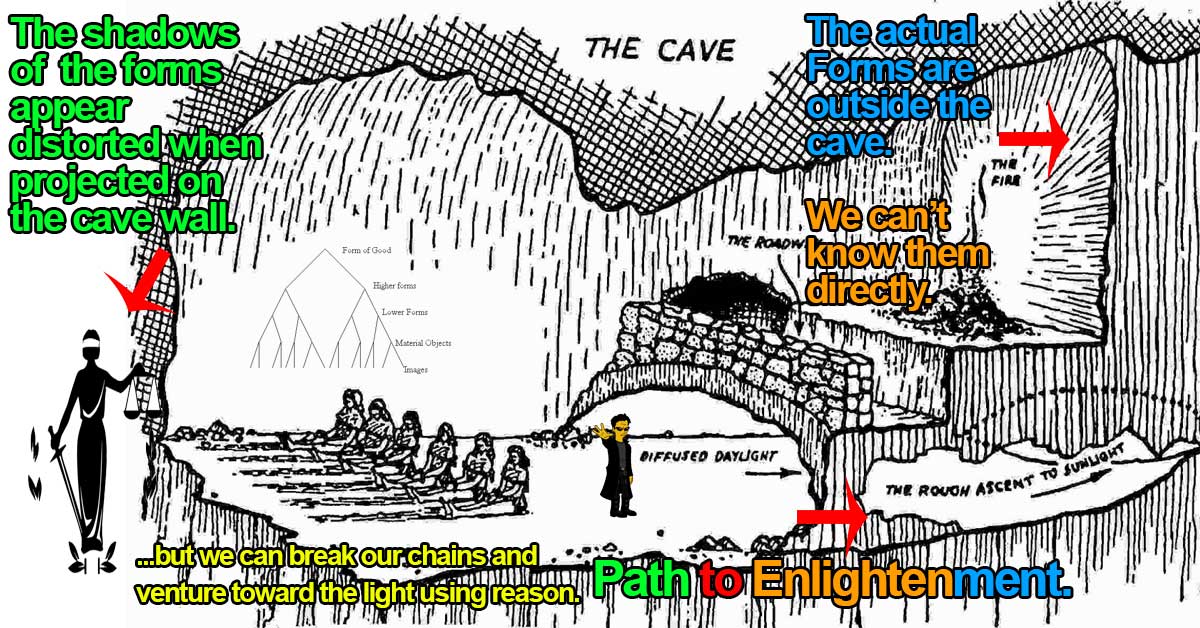
The form of the good, the form of beauty, truth and goodness. The shadows represent false ideas that people live by in this world, or materialism, or whatever, and the objects represent the pure forms that Plato speaks of in the Republic. But they kill him for this because they don't want to have to change, to adapt to a higher truth. Plato represents the philosopher with the brave prisoner who climbs out of the cave to discover the real world, and who wants so badly for his fellow prisoners to know the truth, that he voluntarily climbs back into the cave to tell them. Because the prisoners have never seen the true objects that exist in the world, the objects which are casting those shadows, they believe the shadows are all that is. The shadows represent a false vision of the truth, an illusion about reality. Some people would rather retreat back into the cave than have to first acknowledge, then adapt to the fact that everything they knew was wrong. When Plato speaks of being blinded by the light of the fire, or the sun upon leaving the cave he is discussing the way in which some people will react violently when their cultural world view is challenged to the core of their fundamental belief system. If you had been raised in the thirteenth century your culture's world view (your cave) would have had shadows which led you to believe that the Earth was flat and that it was the center of the Universe. The allegory is a social commentary about understanding what the true nature of the world is, and how many people never see it because of the beliefs of the society they are raised in. To the viewer of the wall, all of reality is represented by shadows. The viewers of the wall have never genuinely seen what the objects which cause those shadows look like. To get through this state, however, it is necessary to continue advancing and discovering new knowledge.The shadows on the wall represent an illusion of reality that the people viewing the wall try to interpret without understanding the truth that the shadows are only shadows. Liberation involves objectively analyzing the extent as to which one’s beliefs falter, which of course produces uncertainty and anxiety. If we have no reason to question something, we don’t, and its falsehood therefore prevails.įew manage to access the second stage, liberation, which is achieved through questioning, research, and study. One of the explanations as to how deception is so profoundly impactful on human life is that, for Plato, it is composed of what seems to be an obviously superficial point of view.

If we compare this by means of the stages of Plato’s allegory, we will obtain a more detailed analysis of the relation of the story to the present.įirst of all, there is deception which posits that the reality provided by these sources of information are merely shadows or breadcrumbs of the intended message or actual truth in other words, the general population consumes information without even questioning it. Various scenarios are easily comparable to these ideas one great example is the information that is shared today across the world’s media, including social networks and the rest of the internet.

#ALLEGORY OF THE CAVE EXPLAINED SERIES#
The story brings together a series of very common philosophical themes, namely, the existence of a truth that exists independently of individuals’ opinions the presence of constant deceptions that keep us from truth and the qualitative change needed in accessing truth.


This entire story is an allusion to Socrates’ effort to help men to reach the truth and their failure in doing so only to be condemned to death himself. When this prisoner tries to untie and raise his former companions towards the light, Plato believes them to be capable of killing him he is sure they would indeed take his life if given the opportunity. The joke would be that this would prove his eyesight to have been impaired by his passage from sunlight to the darkness of the cave. The allegory ends, however, with the prisoner entering the cave once again to “free” his former companions in chains, thereby provoking laughter.


 0 kommentar(er)
0 kommentar(er)
